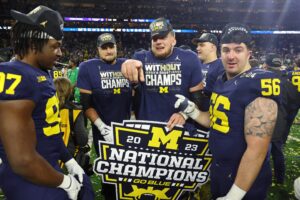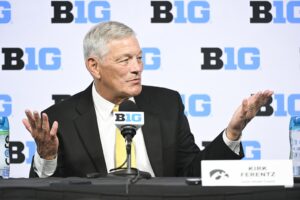Name, Image, and Likeness (NIL) is an effort put forth to give collegiate athletes a chance at compensation from their name. For college athletics in general, it means opportunities for student-athletes to sell their own merchandise, partner with local businesses, or even sell their game-worn apparel. However, things are quickly changing as this idea infiltrates the multi-billion dollar industry that is college football. The wild west of college football’s NIL program is presenting new incentive for players to attend a university. Whether it’s ethical or not, that’s another question.
Recruiting Appeal
High school student-athletes are drawn to a university for a multitude of reasons. These often include a program’s relevance in the national college football landscape, relationships with coaches, school location, and a chance to earn a prestigious education.
In addition to their football programs, colleges and universities offer incredible academic resources for all student-athletes. Schools have founded programs and facilities specifically catered to their athletes. These facilities include guidance counselors, private computer labs, and study halls. They also provide tutoring programs such as degree-specific tutors and essay helpers dedicated to the advancement of the student-athlete.
The University of Alabama has the Bill Battle Academic Center that houses athletic student services inside the famous Paul W. Bryant Hall. On the campus of The University of Iowa, the Gerdin Athletic Learning Center provides impeccable learning services for Hawkeye athletes. In Los Angeles, the John McKay Center is a 110,000 square foot facility that accommodates the Stevens Academic Center for student-athletes. It also holds the football program’s locker room and facilities. The vast assortment of resources dedicated to the student-athlete has become a leading recruiting tool in the world of college athletics.
College Football’s NIL Program
Setting aside the knowledge of players being paid under the table for decades, student-athletes, and football players in particular, have a new reason to be drawn to a university. That reason is NIL.
The latest rendition of this effecting recruiting is the recent news surrounding former Biletnikoff Award winning receiver Jordan Addison. His entry into the transfer portal and subsequent decision to attend USC has many believing that the opportunities of NIL were sizably presented to the former Pitt Panther. Per reports, the NIL money headed Addison’s way is north of $3 million. The funding is reportedly coming from USC’s boosters, who can now “legally” pay players to attend their University. Because it is not the University itself that is making the payment, the boosters can get away with it. Now, the relationship between the University and its boosters might as well be one and the same. The somewhat blurry line between the two is what makes this possible.
The Wild West
The NIL program in college athletics has been in operation for just under one year. At the beginning, players quickly began signing deals with their local car dealerships, restaurants, and even appearing in commercials. This new territory for college football provided a great opportunity for student-athletes to market themselves as a part of the multi-billion dollar industry.
More recently, however, private boosters of the universities have stepped into the arena. These boosters are rumored to be offering up to seven-figure checks to student-athletes. That’s not to say that this is the be-all, end-all incentive for players. But when a school can offer a scholarship, great coaching, and academic prowess, all while private boosters are writing checks, it is that much harder to say no.
The “wild west” is a fitting description for this era of NIL in college athletics. At the moment, there are no definitive rules that say boosters cannot intervene in the finances of NIL. However, the blurry line between compensation for Name, Image, Likeness, and pay-for-play, or even tampering with players’ decisions, has yet to be set. Until then, college football will be in the midst of a free agent market for student-athletes.






